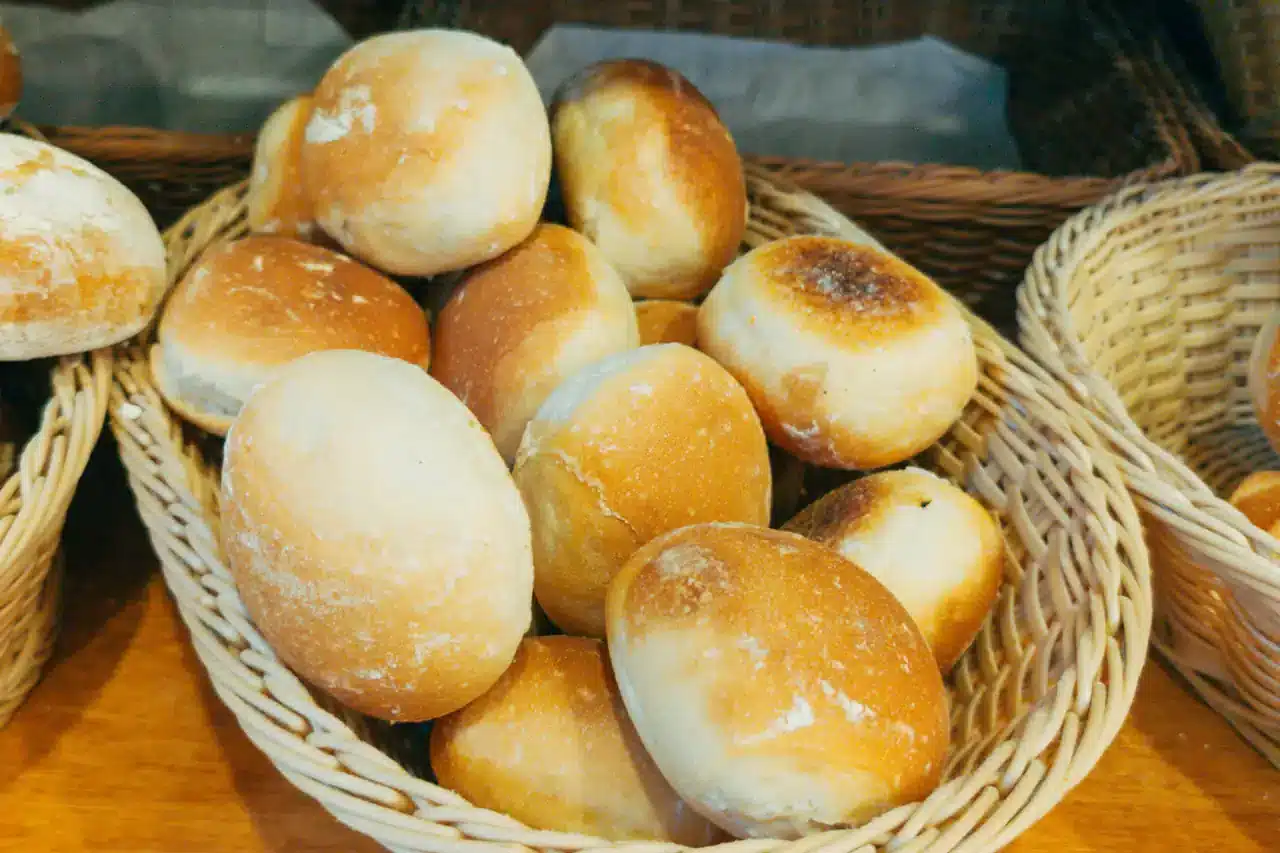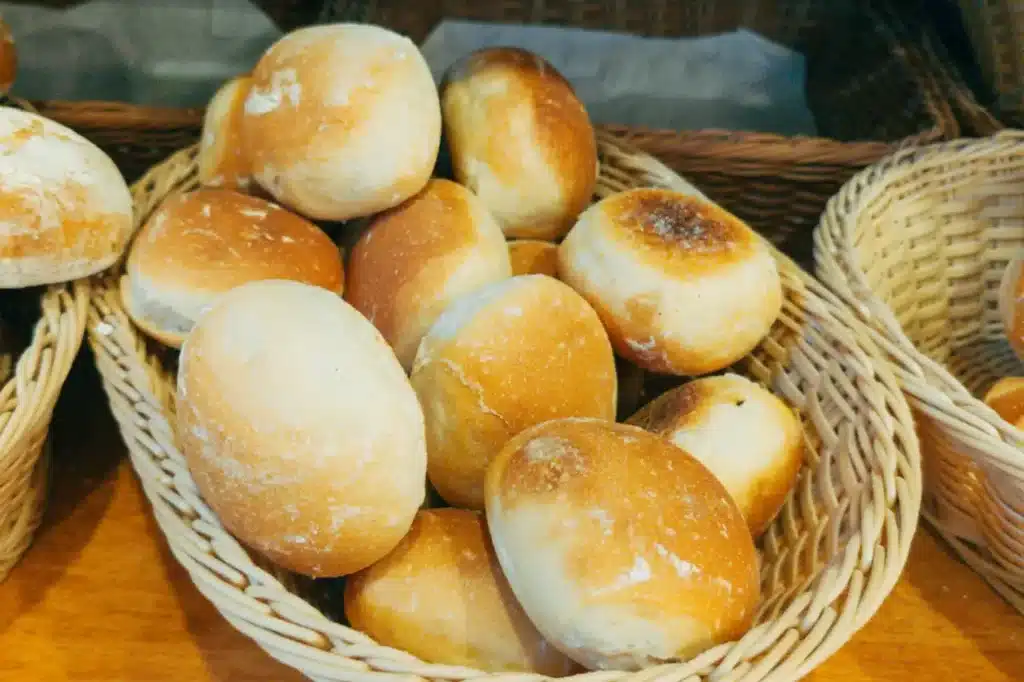Brötchen (also written Broetchen when you can’t type the umlaut) are the classic and iconic German bread rolls – small, light, and crisp-crusted with a tender, cottony crumb. You may have heard different regional names – Semmel (Bavaria/Austria), Schrippe (Berlin), Weck/Weckle (Rhineland/Swabia) – but the idea is the same: a lean wheat roll baked hot with steam so the crust “shatters” when you bite in.
In Germany they’re part of the daily routine. At Frühstück (breakfast), families split warm Brötchen and top them with just Butter and Marmelade, honey, or Quark, or make open-faced sandwiches with cheese and cold cuts. In the evening, many households still enjoy Abendbrot which is a light supper built around bread and toppings – where Brötchen share the table with sliced vegetables, pickles, and spreads. Sundays are special: a quick walk to the local bakery for Sonntagsbrötchen is a common ritual.
Brötchen are also everyday street food too. At markets and football games you’ll find Bratwurst im Brötchen; in Bavaria a warm Leberkässemmel (baked meatloaf in a roll) is classic; in the north, Fischbrötchen stuffed with herring, mackerel, or fried fish are iconic. Bakeries sell belegte Brötchen which are ready-made sandwiches with salami, cheese, egg, or salad for an easy lunch.
Variety is part of the charm: plain white Kaiserbrötchen, poppy- or sesame-seeded rolls, Kürbiskernbrötchen (pumpkin seed), Roggenbrötchen (with rye), and Laugenbrötchen (pretzel rolls). Traditional scoring and steam baking give that shiny, blistered crust. Yesterday’s rolls are never wasted: they become Semmelbrösel (breadcrumbs) or go into Semmelknödel (bread dumplings), which is a beloved side dish.
Brötchen aren’t just a recipe – they’re a little daily rhythm: warm in the morning, shared at the table, sturdy for a grab-and-go bite, and just as good for simple meals as for celebrations.
Time-intensive recipe, yes – delicious, absolutely! Pair with Gulaschsuppe (German goulash soup) for a cozy meal. I hope you love this brotchen recipe as much as I do!

Old Fashioned German Brötchen
Ingredients
Equipment
Method
- Poolish (night before): Stir together poolish ingredients until smooth. Cover loosely; rest at room temp 8–14 hours (bubbly and doubled).
- Make the dough: Mix poolish, flour, water, salt, yeast, and optional malt/honey until shaggy. Knead 8–10 min by hand (or 5–6 min on mixer speed 2) until smooth and slightly tacky.
- First rise: Cover; rise 60–75 min until ~doubled. Halfway through, give one quick fold for strength.
- Divide & pre-shape: Turn out, lightly flour, divide into 10 pieces (~2.8 oz each). Pre-shape into tight balls; rest 10 min.
- Shape: For classic ovals, flatten each ball into a short log, fold long sides to center, seal, then roll seam-side down into a tight oval. Place on parchment.
- Proof: Cover; proof 35–50 min until slightly puffy (a finger dent fills slowly).
- Heat & steam: Preheat to 475°F with steel/stone (or inverted sheet pan) inside. Set a small empty metal pan on a lower rack for steam.
- Score & bake: Mist rolls lightly with water. Slash each once lengthwise about ¼″ deep (or snip with scissors). Slide parchment onto the hot surface. Add ½ cup hot water (or a handful of ice) to the steam pan; close door.
- Bake: 8 min with steam, then remove steam pan, reduce to 430°F, and bake 10–12 min more until deep golden (about 205°F internal).
- Extra crisp: Bake 2 min with door cracked. Cool 15 min on a rack.
Nutrition
Notes
A Note on Poolish
Poolish is a wet, bubbly “starter” used to boost flavor and texture in bread.
It’s a preferment made from equal parts flour and water by weight (100% hydration) plus a pinch of yeast, left to ferment 8–16 hours at room temperature. Think pancake-batter consistency: airy, sweet-smelling, and dotted with bubbles when ripe.
Why bakers use it
- Flavor: gentle acidity and nutty sweetness without sourness
- Crumb: lighter, more open interior
- Crust: thinner, crisper crust that stays fresh longer
- Handling: dough is more extensible (easier to shape)
How to make a small batch (example)
- 200 g flour + 200 g water + ⅛ tsp instant yeast
(In US volume this is roughly 1⅔ cups flour and ~¾ cup + 1 Tbsp + 2 tsp water; volume is imprecise – weight is best.)
Stir smooth, cover loosely, and ferment until doubled, very bubbly, and slightly domed (a light collapse at the center means it’s at peak).
How to use it
- Plan the poolish as 30–50% of total flour in your recipe.
- Mix the ripe poolish into the final dough with the remaining flour, water, salt, and yeast.
Poolish vs. other starters
- Biga: stiffer Italian preferment (about 50–60% hydration), yeastier aroma.
- Sourdough/levain: wild yeast and bacteria (no commercial yeast), tangier.
- Sponge: generic term—can be wet like poolish or firmer like biga.
Tips
- Too boozy/collapsed? It’s overripe – use sooner next time or reduce yeast.
- Warm kitchen? Use less yeast (a pinch) or shorten the ferment; cool kitchen? a bit more yeast or longer time.
- You can refrigerate a ripe poolish up to ~24 hours to hold it for baking later.



FAQ
Your recipe calls for white flour but aren’t Brötchen made with wheat flour?
In U.S. stores, “white whole wheat flour” is a whole-grain flour (bran + germ intact). German bakery rolls typically use refined white wheat flour (similar to U.S. bread flour or unbleached all-purpose). You can still use white whole wheat – just increase the water slightly (1–2 Tbsp in the final dough), add a 20-minute autolyse after mixing, and knead to a soft, slightly tacky dough. Expect a touch more flavor and a heartier crumb.
How do I get that shiny, crackly crust at home?
Preheat a baking steel/stone to 475°F, add steam for the first 8 minutes (mist the rolls and pour ~½ cup hot water into a preheated metal pan on a lower rack), then finish at 430°F until deep golden. Score each roll once lengthwise about ¼″ deep. Cool on a rack to keep the crust crisp.
Do I really need the poolish? Can I make same-day rolls?
The poolish boosts aroma, sweetness, and thin crisp crust. For a same-day version, skip it and mix a straight dough with the same ingredients, increase yeast to 2¼ tsp total, rest 20 minutes (autolyse), then knead and proceed. Flavor will be a bit simpler, but still delicious.
What if I only have all-purpose flour?
Use unbleached all-purpose flour and hold back 1–2 Tbsp water (all-purpose flour absorbs a bit less than bread flour). Everything else stays the same. For extra spring, you can add ½ tsp vital wheat gluten per cup of all-purpose flour (optional).
How do I store and re-crisp leftovers? Can I freeze them?
Same-day is best. Store cooled rolls in a paper bag inside a loose plastic bag at room temp up to 24 hours. To re-crisp: 375°F for 5–7 minutes (spritz with water for extra crackle). Freeze fully cooled rolls in a zip bag up to 3 months; reheat from frozen at 350–375°F for 10–12 minutes. Each roll is about ~185 calories (without toppings).


